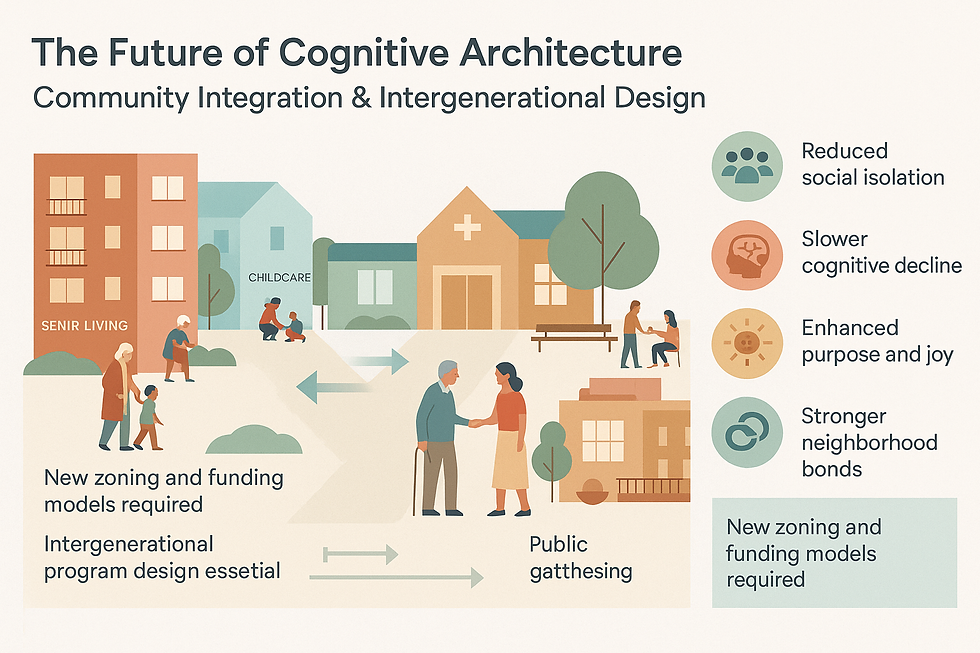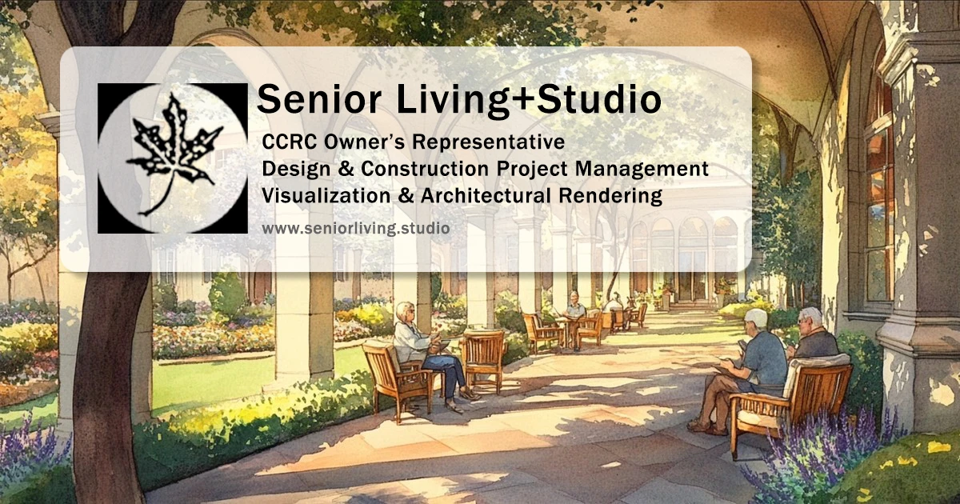Part 2: Applying Cognitive Architecture Design Strategies for Real-World Implementation and Future Innovation
- Senior Living+Studio

- Jul 16
- 13 min read
Theory to Practice: Implementing Cognitive Architecture Design Strategies
The translation of neurobiological insights into architectural practice requires systematic approaches that balance scientific evidence with practical implementation. The success of facilities like The Hogeweyk and emerging projects worldwide demonstrates that cognitive architecture is not merely theoretical but achievable through careful attention to design details and evidence-based strategies.
The implementation of cognitive design strategies requires collaboration between architects, healthcare professionals, and researchers to ensure that built environments truly support brain health rather than merely appearing to do so. This evidence‑based approach to design yields measurable outcomes that justify the additional investment required for specialized expertise.
Lighting design for cognitive health
The implementation of circadian lighting systems represents one of the most impactful interventions available to architects designing for aging populations. Research from the Lighting Research Center at RPI provides specific guidance for creating lighting environments that support cognitive function, mood regulation, and sleep quality.
Effective circadian lighting systems automatically adjust color temperature and intensity throughout the day, providing bright, blue-enriched light (6500K) during morning hours to support alertness and cognitive function, transitioning to warm light (2700K) in the evening to promote relaxation and sleep. These systems can be programmed to account for seasonal variations and individual preferences while maintaining therapeutic benefits.
The WELL Building Standard provides specific requirements for circadian lighting design, including minimum illumination levels of 200 lux during daytime hours and restrictions on blue light exposure during evening hours. These standards offer architects measurable targets for creating cognitively supportive lighting environments.

Practical Implementation Strategies
Successful lighting design for senior living requires careful attention to age-related visual changes. Seniors require 2-3 times more light than younger adults for the same visual tasks, while being more sensitive to glare and contrast. Lighting systems must provide adequate illumination while avoiding harsh shadows and reflective surfaces that can create confusion or disorientation.
The integration of natural light through strategic window placement and light shelves can provide the high-intensity illumination necessary for circadian support while creating connections to the outdoor environment. When natural light is insufficient, LED lighting systems with tunable white technology can provide the intensity and color temperature variations necessary for cognitive support.

Acoustic design for cognitive clarity
The acoustic environment profoundly impacts cognitive function in aging populations, requiring careful attention to both sound control and enhancement. Research demonstrates that background noise levels exceeding 45 dB in residential areas can impair cognitive performance and increase behavioral disturbances in seniors with dementia.
Sound Absorption and Control
Effective acoustic design begins with sound absorption through ceiling tiles, carpet, and wall treatments that reduce reverberation and background noise. The integration of sound-absorbing materials must be balanced with durability and infection control requirements, often leading to innovative solutions like perforated metal ceiling systems with acoustic backing.
Mechanical systems require particular attention, as HVAC noise can significantly impact speech intelligibility and cognitive load. Sound attenuators, proper duct design, and equipment selection can minimize mechanical noise while maintaining necessary ventilation and temperature control.

Therapeutic Sound Integration
Beyond noise control, acoustic design can actively support cognitive health through therapeutic sound integration. Water features, nature sounds, and carefully selected music can provide positive auditory stimulation while masking less desirable sounds. The emerging research on 40-Hz auditory stimulation for Alzheimer's treatment suggests that specific sound frequencies may have direct therapeutic benefits.

Material selection and cognitive architecture
The selection of materials, colors, and textures significantly impacts cognitive function through their influence on perception, navigation, and emotional response. Research-based guidelines for material selection provide architects with specific criteria for creating cognitively supportive environments.
Visual Contrast and Wayfinding
The strategic use of color and contrast supports spatial orientation and safety in aging populations. Research recommends minimum 70% Light Reflectance Value (LRV) differences between surfaces to ensure adequate contrast for aging vision. Door frames, handrails, and other important elements should contrast with surrounding surfaces to support recognition and navigation.
Color selection must consider both contrast requirements and psychological effects. Warm colors can increase appetite and social interaction, while cool colors may have calming effects. The avoidance of busy patterns and high-contrast combinations that can create visual barriers is particularly important for seniors with dementia.
Tactile and Sensory Considerations
Material selection must address declining tactile sensitivity in aging populations while providing appropriate sensory feedback. Smooth surfaces should be avoided in favor of subtly textured materials that provide tactile information without creating maintenance challenges. Handrails and frequently touched surfaces should provide clear sensory feedback about location and direction.
The integration of familiar materials like wood and stone can provide emotional comfort and support cognitive function through association with home environments. However, these materials must be selected for durability and maintenance requirements while maintaining their therapeutic benefits.

Wayfinding and spatial navigation systems
The design of wayfinding systems for aging populations requires understanding of how spatial cognition changes with age and how environmental cues can support or hinder navigation. Effective wayfinding systems combine multiple design strategies to create legible, memorable environments.
Landmark-Based Navigation
Research shows that seniors increasingly rely on landmark-based navigation strategies rather than cognitive mapping. The placement of distinctive landmarks at decision points, combined with consistent visual cues, supports spatial orientation and reduces anxiety associated with navigation difficulties.
Landmarks should be memorable, distinctive, and meaningful to the intended population. Cultural references, natural elements, and familiar objects can serve as effective landmarks while providing emotional comfort and cognitive stimulation.
Integrated Signage Systems
Effective signage systems combine text and pictograms at consistent heights (48-60 inches above floor) with appropriate text size (minimum 5/8 inch for standard viewing distance). The integration of lighting and color coding enhances visibility while providing additional navigational cues.
Signage placement should follow consistent patterns throughout the facility, with information provided at decision points and confirmation provided along routes. The use of consistent fonts, colors, and symbols reduces cognitive load while supporting recognition and memory.

Outdoor environments and therapeutic landscapes
The design of outdoor spaces for senior living facilities requires careful attention to safety, accessibility, and therapeutic benefits. Research demonstrates that access to nature and outdoor environments provides measurable benefits for cognitive health, physical activity, and social interaction.

Secure Garden Design
Therapeutic gardens for seniors with dementia must balance exploration opportunities with safety requirements. Secure perimeters that are visually unobtrusive, circular or figure-eight path systems that prevent dead ends, and strategic placement of seating areas create safe exploration opportunities while reducing anxiety.
The integration of seasonal interest through plant selection, water features, and outdoor art provides sensory stimulation and cognitive engagement throughout the year. Raised beds and accessible garden plots allow for therapeutic horticulture activities that support cognitive function and social interaction.

Biophilic Design Integration
The 14 patterns of biophilic design provide frameworks for integrating nature into senior living environments. Direct nature connections through plants and water features, indirect connections through natural materials and views, and spatial configurations that mimic natural environments all provide therapeutic benefits.
Indoor plants and living walls can provide year-round access to nature while improving air quality and providing sensory stimulation. The integration of natural light through skylights and large windows creates connections to outdoor environments even when direct access is limited.

Technology integration and smart environments
The integration of technology into senior living environments offers opportunities to support cognitive health while maintaining privacy and dignity. Smart home technologies, when properly implemented, can provide cognitive support without being intrusive or overwhelming.
Ambient Intelligence Systems
Environmental sensors that monitor motion, temperature, humidity, and lighting can provide valuable information about resident wellbeing while supporting automated systems that adjust environmental conditions for optimal cognitive function. Studies show that smart home technologies can help older adults manage chronic conditions and maintain independence when properly designed.

Voice-activated controls for lighting, temperature, and entertainment systems can support independence while accommodating age-related changes in mobility and dexterity. However, these systems must be carefully designed to avoid confusion or frustration that could undermine their benefits.
Cognitive Support Applications
Mobile applications and tablet-based systems can provide cognitive stimulation, medication reminders, and communication tools while being specifically designed for aging populations. Research on digital interventions for healthy aging shows that technology-based cognitive training can improve cognitive function in older adults when properly implemented.

The integration of technology with environmental design creates opportunities for personalized cognitive support. Smart lighting systems that adjust based on individual circadian rhythms, personalized wayfinding systems that adapt to individual navigation preferences, and customized environmental controls can provide individualized support within shared living environments.
Case Study: Village Landais Alzheimer, France

The Village Landais Alzheimer in Dax, France, represents a cultural adaptation of The Hogeweyk model, demonstrating how universal design principles can be modified for specific cultural contexts while maintaining therapeutic effectiveness. This €28.8 million project provides insights into the scalability and adaptability of cognitive architecture.
Cultural Adaptation and Local Context
The Village Landais was designed by NORD Architects to reflect the vernacular architecture of medieval bastide towns typical of the Landes region. This cultural adaptation demonstrates that cognitive architecture must be grounded in local context and cultural memory to be effective.
The facility's four neighborhoods contain 16 houses accommodating 7-8 residents each, grouped around a central bastide containing grocery store, library, auditorium, medical center, and hair salon. This spatial organization provides multiple scales of social interaction while maintaining security and familiarity.
Research Integration and Evaluation
The Village Landais includes a Resource and Research Centre that conducts ongoing evaluation of the facility's effectiveness. Research led by Hélène Amieva from the University of Bordeaux is examining social participation, caregiver stress, family guilt, and maintenance of relationships compared to traditional nursing home settings.
Preliminary results indicate positive changes in public perception of Alzheimer's disease and improved quality of life for residents. The facility's research component demonstrates the importance of ongoing evaluation in developing evidence-based design approaches.
Financial Model and Sustainability
The Village Landais' annual operating cost of €7 million serves 120 residents with 120 staff members, creating a 1:1 staff-to-resident ratio that enables personalized care. While this model requires significant investment, the facility demonstrates that innovative care models can be financially sustainable when properly designed and operated.
The integration of community programming and volunteer support (120 volunteers from local associations) creates cost efficiencies while providing meaningful social interaction. This model suggests that cognitive architecture can support both therapeutic goals and financial sustainability.

Case Study: Green Houses Model, USA
The Green Houses model represents a different approach to cognitive architecture, focusing on small-scale group living within larger senior living communities. This model demonstrates how cognitive design principles can be implemented within existing regulatory and financing frameworks.
Small-Scale Living Philosophy
Green Houses typically accommodate 10-12 residents in homelike environments with private bedrooms and shared living areas. This scale provides the intimacy and familiarity necessary for cognitive support while maintaining the efficiency and safety standards required for skilled nursing care.
The spatial organization emphasizes residential-style living with domestic kitchens, living rooms, and outdoor spaces that create opportunities for meaningful activity and social interaction. This approach demonstrates that cognitive architecture can be implemented within existing care delivery models.
Measured Outcomes and Benefits
Green Houses demonstrate measurable improvements in resident satisfaction, staff retention, and family engagement compared to traditional nursing home environments. Residents show improved cognitive function, reduced medication use, and enhanced quality of life measures.
The model's success lies in its integration of environmental design with care delivery philosophy. Staff training emphasizes person-centered care within supportive physical environments, creating synergies between design and care approaches.
[Image placeholder: Interior photography showing Green House residential-style living spaces with domestic furnishings, kitchen areas, and outdoor connections, accompanied by floor plans showing household organization]
Developing a cognitive architecture framework
The evidence from successful projects worldwide suggests the need for a comprehensive framework for cognitive architecture that can guide designers, operators, and regulators in creating supportive environments for aging populations.

Core Design Principles
A cognitive architecture framework must integrate multiple design strategies into coherent approaches that support brain health. The Fleming-Bennett Framework provides 10 key principles that can guide design decisions:
Unobtrusively reduce risks through environmental design
Provide human-scale environments that feel familiar and comfortable
Allow people to see and be seen, supporting social interaction and safety
Reduce unhelpful stimulation that can cause confusion or agitation
Optimize helpful stimulation that supports cognitive function
Support movement and engagement through accessible design
Create familiar places that evoke positive memories and associations
Provide variety of spaces for solitude and social interaction
Link to the broader community to prevent isolation
Design in response to vision for way of life that respects individual preferences
Implementation Guidelines
The implementation of cognitive architecture requires systematic approaches that address multiple design scales from site planning to material selection. Design guidelines should provide specific criteria for:
Spatial organization and circulation patterns
Lighting design and circadian support
Acoustic environments and sound control
Material selection and sensory design
Wayfinding and navigation systems
Outdoor environments and nature integration
Technology integration and smart systems
Social spaces and community design
Measurement and Evaluation
Effective cognitive architecture requires ongoing measurement and evaluation to ensure that design interventions achieve intended outcomes. Post-occupancy evaluation should include:
Cognitive function assessments
Behavioral observations
Staff and family satisfaction surveys
Operational efficiency metrics
Safety and quality indicators
Cost-benefit analyses
Standards integration and regulatory considerations
The successful implementation of cognitive architecture requires integration with existing building codes, healthcare regulations, and professional standards. The WELL Building Standard, ANSI/ASHA accessibility requirements, and evidence-based design guidelines provide frameworks for creating compliant environments that support cognitive health.
WELL Building Standard Integration

The WELL Building Standard v2 provides specific requirements for senior living environments that align with cognitive architecture principles. The standard's 10 concepts—air, water, nourishment, light, movement, thermal comfort, sound, materials, mind, and community—provide measurable criteria for creating supportive environments.
Key WELL requirements for senior living include minimum illumination levels of 200 lux during daytime hours, background noise limits of 45 dB in residential areas, and specific requirements for air quality and thermal comfort. These standards provide architects with measurable targets for creating cognitively supportive environments.
Accessibility and Universal Design
The integration of cognitive architecture with accessibility requirements creates opportunities for creating truly inclusive environments. The ANSI/RESNA CA-1:2018 Cognitive Accessibility standards provide specific guidance for creating environments that support cognitive function while meeting accessibility requirements.
Universal design principles align with cognitive architecture goals by creating environments that are usable by people with diverse abilities and needs. The seven principles of universal design—equitable use, flexibility in use, simple and intuitive use, perceptible information, tolerance for error, low physical effort, and size and space for approach and use—provide frameworks for creating supportive environments.
[Image placeholder: Regulatory compliance matrix showing integration of cognitive architecture principles with building codes, healthcare regulations, and accessibility standards.
Business case for cognitive architecture
The financial benefits of cognitive architecture extend beyond initial construction costs to encompass long-term operational savings, improved outcomes, and market differentiation. Research demonstrates that evidence-based design investments typically recoup costs within 1-2 years through operational savings and continue providing benefits for several years.
Operational Cost Savings
Cognitive architecture provides measurable cost savings through reduced medication use, lower staff turnover, fewer medical interventions, and improved operational efficiency. Studies show 20-30% reductions in psychotropic medication use, 25% reductions in staff turnover, and significant decreases in emergency department visits and hospitalizations.
The Agency for Healthcare Research and Quality analysis of a $12 million evidence-based design investment found that construction costs were recovered within one year through operational savings, with continuing benefits for several years. This return on investment demonstrates the financial viability of cognitive architecture approaches.
Market Differentiation and Premium Pricing
Well-designed senior living facilities can command premium pricing while maintaining higher occupancy rates. Quality design supports higher census levels, improved resident satisfaction scores, and enhanced reputation that attracts both residents and staff.
The growing awareness of cognitive health and the expanding market of educated consumers creates opportunities for facilities that can demonstrate measurable benefits of their design approaches. This market differentiation becomes increasingly important as the industry faces growing competition and rising consumer expectations.
Long-Term Value Creation
The demographic trends driving senior living demand—47% increase in 80+ population over the next decade—create long-term value for facilities that can demonstrate superior outcomes. The projected $275 billion supply shortage by 2030 suggests that high-quality facilities will be increasingly valuable assets.

The future of cognitive architecture
The evolution of cognitive architecture will be shaped by advancing neuroscience research, emerging technologies, and changing demographic needs. Several trends suggest directions for future development:
Personalized Environmental Design
Advances in neuroscience and technology will enable increasingly personalized approaches to environmental design. Individual differences in cognitive function, sensory abilities, and personal preferences will inform customized environmental interventions that optimize cognitive support for each resident.
Wearable devices and environmental sensors will provide real-time feedback about individual responses to environmental conditions, enabling dynamic adjustments to lighting, temperature, acoustics, and other factors. This personalized approach will move beyond one-size-fits-all solutions toward individually optimized environments.
Integration with Medical Treatment
The emerging research on light therapy, sound therapy, and environmental interventions for Alzheimer's disease suggests that cognitive architecture will increasingly integrate with medical treatment protocols. The 40-Hz light and sound stimulation showing promise for Alzheimer's treatment could be integrated into architectural lighting and acoustic systems.
This integration will require closer collaboration between architects, healthcare professionals, and researchers to ensure that built environments support rather than interfere with medical treatments. The development of evidence-based protocols for environmental interventions will be crucial for widespread adoption.
Community-Centered Approaches
Future cognitive architecture will increasingly focus on community integration and intergenerational programming. The recognition that social isolation accelerates cognitive decline will drive designs that connect senior living facilities with broader community networks.

Mixed-use developments that integrate senior housing with childcare, retail, and community services will create opportunities for meaningful intergenerational interaction. These approaches will require new regulatory frameworks and financing mechanisms that support community-centered development.
Conclusion: The imperative for expert guidance
The complexity of cognitive architecture requires specialized expertise that goes beyond traditional architectural practice. The integration of neuroscience research, evidence-based design principles, regulatory requirements, and financial considerations demands consultants who understand both the science and the practice of creating supportive environments for aging populations.
The business case for engaging specialized consultants is compelling. The 21.25% to 45% reduction in design and construction time achieved through systematic approaches can save millions in project costs while ensuring that facilities meet the complex requirements of cognitive architecture. The alternative—retrofitting poorly designed facilities or accepting suboptimal outcomes—is far more expensive and disruptive.
Why Senior Living Studio Makes the Difference

Senior Living Studio represents the specialized expertise needed to navigate the complex landscape of cognitive architecture. As senior living owner's representatives, they bring deep understanding of both the science and the business of creating supportive environments for aging populations.
Their approach combines evidence-based design principles with practical implementation strategies, ensuring that projects not only meet therapeutic goals but also achieve financial sustainability and operational efficiency. With the senior living industry facing unprecedented growth and evolving consumer expectations, the expertise provided by Senior Living Studio can mean the difference between a successful project and a costly failure.
The statistics are compelling: facilities designed with cognitive architecture principles show 20-30% reductions in operational costs, 25% improvements in staff retention, and significantly higher resident satisfaction scores. These improvements translate directly to bottom-line benefits that justify the investment in specialized consulting services.
More importantly, the human cost of poorly designed senior living facilities is immeasurable.
When 57 million people worldwide live with dementia, and that number is projected to reach 139 million by 2050, the responsibility to create supportive, dignified environments becomes not just a business opportunity but a moral imperative.
The architecture of aging is not merely about buildings—it's about creating environments that support human dignity, cognitive health, and quality of life during the most vulnerable years of life. The science exists, the evidence is clear, and the expertise is available. The question is whether we have the will to create the built environments that aging populations deserve.
In the end, cognitive architecture represents a fundamental shift in how we think about the built environment's role in human health and wellbeing. It requires expertise, investment, and commitment to excellence that goes beyond conventional practice. For senior living developers and operators, partnering with specialists like Senior Living Studio is not just a smart business decision—it's an investment in the future of aging with dignity.

